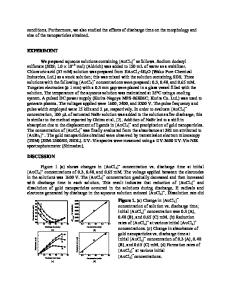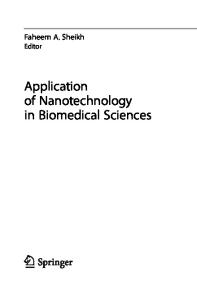Novel Synthesis of Gold Nanoparticles in Aqueous Media
- PDF / 283,267 Bytes
- 6 Pages / 612 x 792 pts (letter) Page_size
- 82 Downloads / 384 Views
0901-Ra16-55-Rb16-55.1
Novel Synthesis of Gold Nanoparticles in Aqueous Media
A. Sugunan and J. Dutta Microelectronics, School of Engineering and Technology, Asian Institute of Technology, Pathumthani, 12120, Thailand ABSTRACT
Aqueous synthesis of glutamate functionalized single crystal gold nanoparticles was achieved by reducing a solution of chloroauric acid with monosodium glutamate. Highly uniform size distributions of the nanoparticles can be obtained by having an excess of monosodium glutamate in the starting solution. Similar to the conventional synthesis of gold nanoparticles by reduction of chloroauric acid with trisodium citrate, the obtained particle sizes were varied in the range of 14 – 25 nm without loosing the uniformity in its size distribution by varying the concentration of the reducing agent. INTRODUCTION
Colloidal gold nanoparticles have been studied for over 100 years, mostly directed towards a better understanding of their physical and chemical properties like surface plasmon absorption and catalytic activities [1]. The ‘near monodisperse’ size distribution of the particles of these colloids was of special interest in order to test various theoretical models of colloidal stability and acquire knowledge on the nature of particle agglomeration process [2], self assembly of colloidal particles in two dimensional or more complex three dimensional (3D) superstructures [3], amongst others. In recent years, application of colloidal gold nanoparticles as sensors for a wide variety of analytes, like heavy metal cations [4] and biological molecules [5] has attracted a renewed attention from researchers. One of the most widely used precipitation methods for the synthesis of gold colloids , proposed by Turkevich, in water involves the reduction of an aqueous solution of chloroauric acid (HAuCl4) by trisodium citrate [1,6]. These nanoparticles are known to be stabilized by a physical adsorption of excess citrate ions from the medium [6]. For most biological applications like bio-sensors and novel assemblies based of biological structures, use of conventional gold nanoparticles involves an additional step of ligand exchange with a bio-molecule that often leads to de-stabilization of the colloidal suspension. This can be avoided by employing bio-available molecules like acidic amino acids to reduce chloroauric acid to form gold nanoparticles with bio-compatible surface properties. Successful attempts to use amino acids as a reducing agent for chloroauric acid have been reported for aspartic acid [7]. To the best of our knowledge this is the first report on the precipitation and characterization of gold nanoparticles utilizing the amino acid derivative, monosodium glutamate (MSG). Morphology, crystallinity and surface properties of the synthesized gold nanoparticles obtained at varying experimental conditions are presented and discussed.
0901-Ra16-55-Rb16-55.2
EXPERIMENTAL DETAILS
Stock solutions of 5 mM chloroauric acid (Sigma-Aldrich) in de-ionized water (Solution A) and 25 mM monosodium glutamate (S
Data Loading...











